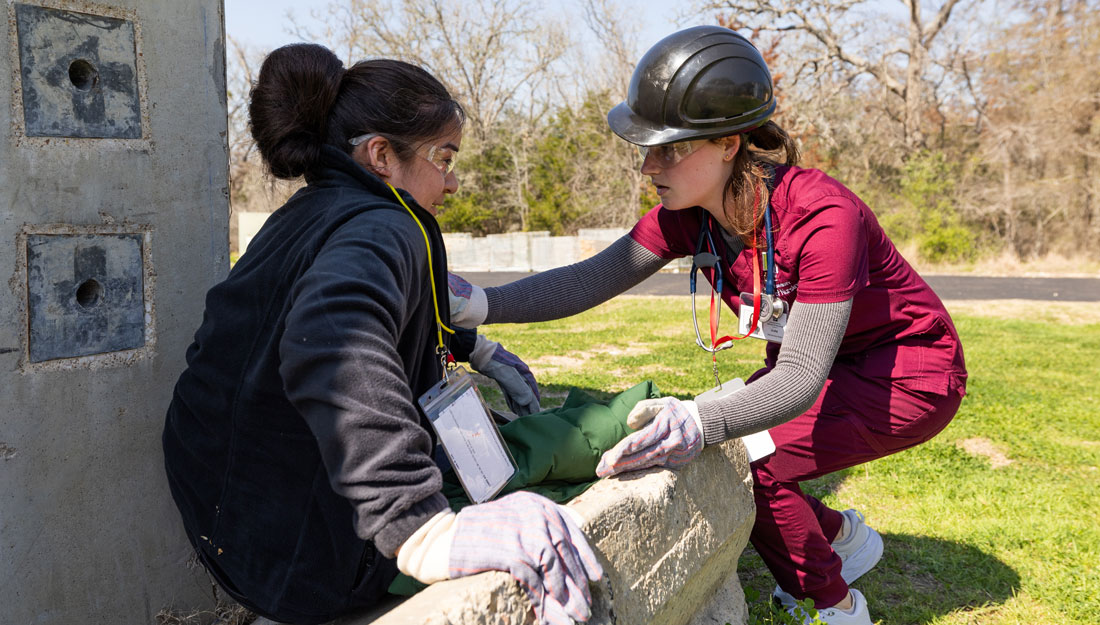- Kala McCain
- Featured, Nursing, Research, Show on VR homepage
Study finds relationship between stranded motorist injuries, deaths and risk factors
Collaboration between health care providers and death investigation agency supports evidence-based outcomes to reduce stranded motorist loss of life on Texas highways

In an analysis of traffic accidents resulting in injury of stranded motorists, Stacy A. Drake and her fellow research team found that of 219 instances reported, more than 77 percent of victims were outside a vehicle at the time of injury.
When a victim of a traffic accident is brought to an emergency department, the details surrounding their injuries are documented from the perspective of treatment, but details of how the injury occurred usually are not. In looking at injury and death data related to vehicle crashes or auto-pedestrian incidents, an interprofessional team of researchers found that those involving stranded motorists—a crash involving a stopped or stalled vehicle on a roadway or shoulder—were not uniquely identified.
“In an effort to fill this gap, data fields to identify additional circumstantial information were added into existing databases at a medical examiner’s office and two Level I trauma centers in the Houston metroplex,” said Stacy A. Drake, PhD, MPH, RN, AFN-BC, D-ABMDI, FAAN, associate professor in forensic nursing at Texas A&M University College of Nursing. “In Harris County alone, incidents involving stranded motorists result in approximately two pedestrian freeway deaths per month, and roughly two individuals sustain injuries requiring Level 1 trauma care. Understanding the factors associated with these deaths helps support proactive, evidence-based initiatives in preventing freeway pedestrian deaths and serious injuries which ultimately will reduce emergency trauma visits and save lives.”
Over a 5-year period, the partnering medical examiner’s office and trauma centers collected injury-related information noting whether the victim was a stranded motorist at the time of impact. Drake and her fellow research team analyzed the data to determine the risk factors associated with the injury patterns found. “Of 219 instances reported, more than 77 percent of victims were outside a vehicle at the time of injury,” Drake said. “And nearly 25 percent of pedestrian victims sustained spinal injuries with 46 out of 54 succumbing to those injuries.”
The numbers are staggering, especially when considering these serious injuries and fatalities are often a direct result of secondary crashes where pedestrians remain on the freeway, outside a vehicle, and trust those passing by will not cross the solid white line. As a forensic nurse specializing in death investigation, Drake was recently selected to serve on Houston TranStar’s It’s Only a White Line Leadership Council, and the findings from the research study provide evidence-based guidance in supporting the campaign’s initiative to reduce fatalities related to stalled or stopped vehicles on the area highways. Drake works alongside fellow regional experts in understanding and preventing roadway tragedies caused largely by secondary—and avoidable—crashes.
There are more than five million registered vehicles just in Houston TranStar’s service area alone. “We see approximately 1,200 crashes monthly on our freeways and somewhere in the neighborhood of 7,000 vehicle stalls,” said Dinah Massie, executive director of Houston TranStar. “Every minute a traveler is stopped on a freeway, the risk of being seriously injured or killed in a secondary crash increases dramatically.”
The outcomes of Drake’s research illustrate the importance of interprofessional collaboration to provide data useful for health care providers in documenting evidence, emergency response personnel in patient priority stabilization and injury prevention specialists for highway safety programs.
The full research article, entitled “Fatal and non-fatal injury patterns of stranded motorists,” was recently published in the April 2021 issue of the Journal of Forensic Nursing, the official journal of the International Association of Forensic Nurses published in partnership with Wolters Kluwer Health/Lippincott, Williams & Wilkins.
Media contact: media@tamu.edu


